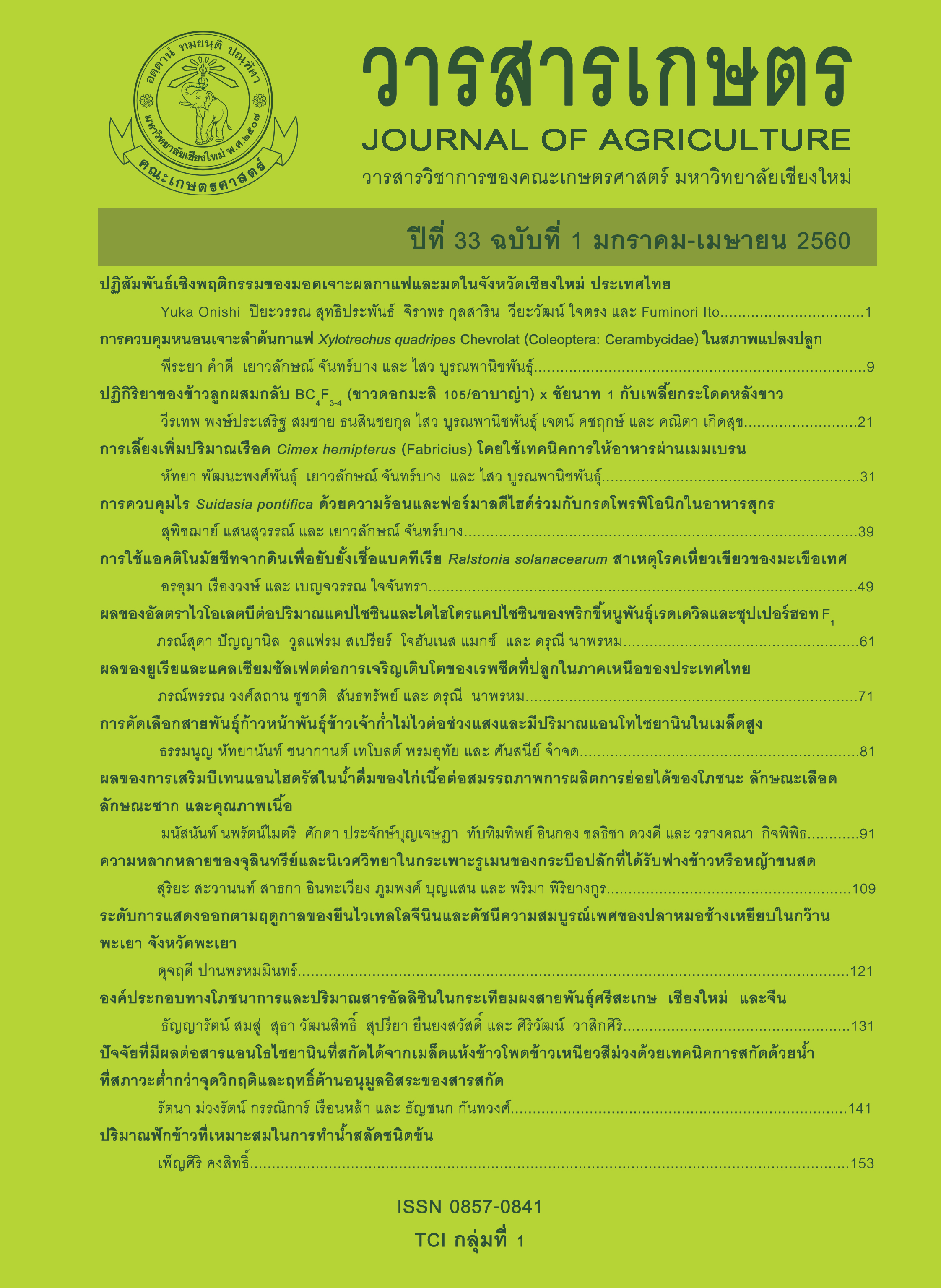ผลของยูเรียและแคลเซียมซัลเฟตต่อการเจริญเติบโตของเรพซีด ที่ปลูกในภาคเหนือของประเทศไทย
Main Article Content
บทคัดย่อ
การศึกษาผลของยูเรียและแคลเซียมซัลเฟตต่อการเจริญเติบโตรวมถึงคุณภาพและปริมาณผลผลิตของเรพซีดพันธุ์ Rapool Comfort ทำการทดลอง ณ ศูนย์วิจัยเกษตรหลวงเชียงใหม่ ตำบลแม่วิน อำเภอจอมทอง จังหวัดเชียงใหม่ ระดับความสูง 1,300 เมตรเหนือระดับน้ำทะเลปานกลาง วางแผนการทดลองแบบสุ่มในบล็อกสมบูรณ์ (RCBD) ทำการทดลอง 3 บล็อก และให้ปุ๋ย 5 กรรมวิธีได้แก่ ควบคุม (ไม่ใส่ปุ๋ย) ยูเรีย 21 กก./ไร่ ยูเรีย 42 กก./ไร่ แคลเซียมซัลเฟต 17 กก./ไร่ และ แคลเซียมซัลเฟต 35 กก./ไร่ โดยแบ่งให้ปุ๋ย 2 ครั้งในช่วงการเจริญเติบโต คือ ครั้งที่ 1 ให้ปุ๋ยร้อยละ 40 ของแต่ละกรรมวิธีในระยะการยืดตัวของลำต้น และครั้งที่ 2 ให้ปุ๋ยร้อยละ 60 ของแต่ละกรรมวิธีในระยะการแทงช่อดอก ผลการศึกษาพบว่าการให้ปุ๋ยยูเรียทั้ง 2 อัตรา และปุ๋ยแคลเซียมซัลเฟต 17 กก./ไร่ มีความสูงของต้นระหว่าง 44.87-48.97 เซนติเมตร ในสัปดาห์ที่ 18 หลังย้ายปลูก ซึ่งไม่แตกต่างจากกรรมวิธีควบคุม แต่มากกว่ากรรมวิธีที่ให้ปุ๋ยแคลเซียมซัลเฟต 35 กก./ไร่ อย่างมีนัยสำคัญทางสถิติที่ความสูงของต้นที่ 38.30 เซนติเมตร ในขณะที่จำนวนใบ และจำนวนต้นที่ออกดอกไม่มีความแตกต่างกันในทุกกรรมวิธี การให้ปุ๋ยแคลเซียมซัลเฟต 17 กก./ไร่ ที่ให้จำนวนดอกน้อยกว่ากรรมวิธีควบคุมอย่างมีนัยสำคัญทางสถิติ ในขณะที่กรรมวิธีอื่นไม่มีความแตกต่างกัน การให้ปุ๋ยยูเรีย 42 กก./ไร่ ทำให้มีการติดฝักน้อยกว่ากรรมวิธีอื่น ๆ อย่างมีนัยสำคัญทางสถิติ ในขณะที่การใส่ปุ๋ยแคลเซียมซัลเฟต 35 กก./ไร่ ทำให้การติดฝัก จำนวนเมล็ด และผลผลิตเพิ่มขึ้น อีกทั้งยังให้ปริมาณน้ำมันมากกว่ากรรมวิธีควบคุมอย่างมีนัยสำคัญทางสถิติ องค์ประกอบของน้ำมันเรพซีดพันธุ์ Rapool Comfort ประกอบด้วยกรดไขมัน 5 ชนิด ได้แก่ โอเลอิก (omega 9) ร้อยละ 62.60 ลิโนเลอิก (omega 6) ร้อยละ 19.48 ลิโนเลนิก (omega 3) ร้อยละ 8.04 ปาล์มิติก ร้อยละ 5.15 สเตียริก ร้อยละ 3.22 และกรดไขมันอื่น ๆ ร้อยละ 1.51
Article Details
เอกสารอ้างอิง
พิทยา สรวมศิริ. 2555. ธาตุอาหารในการผลิตพืชสวน. คณะเกษตรศาสตร์ มหาวิทยาลัยเชียงใหม่, เชียงใหม่. 326 หน้า.
มงคล ต๊ะอุ่น. 2548. เทคนิคและการวิเคราะห์ในห้องปฏิบัติ การดิน พืช ดิน น้ำและปุ๋ย. ภาควิชาทรัพยากรที่ดินและสิ่งแวดล้อม คณะเกษตรศาสตร์ มหาวิทยาลัยขอนแก่น, ขอนแก่น. 300 หน้า.
สมเจตน์ ศรีทองคำ. 2532. ความต้องการธาตุฟอสฟอรัสและซัลเฟอร์ของถั่วเหลืองที่ปลูกในชุดดินที่สำคัญทางภาคเหนือของประเทศไทย. วิทยานิพนธ์วิทยาศาสตรมหาบัณฑิต. มหาวิทยาลัยเชียงใหม่, เชียงใหม่. 111 หน้า.
Abdallah, M., L. Dubousset, F. Meuriot, P. Etienne, J.C. Avice and A. Ourry. 2010. Effect of mineral sulphur availability on nitrogen and sulphur uptake and remobilization during the vegetable growth of Brassica napus L. Journal of Experimental Botany 61(10): 2635-2646.
Ahmad, A. and M.Z. Abdin. 2000. Interactive effect of sulphur and nitrogen on the oil and protein concentrations and on the fatty acid profiles of oil in the seeds of rapeseed (Brassica campestris L.) and mustard (Brassica juncea L. Czern. and Coss.). Journal of Agronomy and Crop Science 185(1): 49-54.
Ahmadi, M. and M.J. Bahrani. 2009. Yield and yield components of rapeseed as influenced by water stress at different growth stages and nitrogen levels. American-Eurasian Journal of Agricultural & Environmental Sciences 5(6): 755-761.
Appelqvist, L.Å. and R. Ohlson. 1972. Rapeseed: Cultivation, Composition, Processing and Utilization. Elsevier Publishing Company, Inc., New York. 391 p.
Asare, E. and D.H. Scarisbrick.1995. Rate of nitrogen and sulphur fertilizers on yield, yield components and seed quality of oilseed rape (Brussica napus L.). Field Crops Research 44: 41-46.
Bouchet, A.S., A. Laperche, C. Bissuel-Belaygue, R. Snowdon, N. Nesi and A. Stahl. 2016. Nitrogen use efficiency in rapeseed: A review. Agronomy for Sustainable Development 36(2): 1-20.
Brennan, R.F. 2016. Effect of time of application and amount of nitrogen fertilizer on seed yield and concentration of oil in canola (Brassica napus). Plant Nutrition 39: 337-347.
Chongo, G. and P.B.E. McVetty. 2000. Relationship of physiological characters to yield parameters in oilseed rape (Brassica napus L.). Can. Plant Science 81(1): 1-6.
De Pascale, S., A. Maggio, F. Orsini, A. Bottino and G. Barbieri. 2008. Sulphur fertilization affects yield and quality of friarielli (Brassica rapa L.) subsp. sylvestris L. Janch. var. esculenta Hort.) grown on a floating system. Journal of Horticultural Science and Biotechnology 83: 743-748.
Department of Primary Industries (DPI). 2011. Canola growth & development. Department of Primary Industries, State of New South Wales. 88 p.
FAO. 2007. The State of Food and Agriculture. FAO Agriculture Series No. 38. Rome. 240 p.
Franzen, D.W. and J. Lukach. 1997. Fertilizing mustard and canola. Bull. North Dakota State University Extension Service. North Dakota State University, Fargo, ND. 8 p.
Gallejones P., A. Castello´n, A. del Prado, O. Unamunzaga and A. Aizpurua. 2012. Nitrogen and sulphur fertilization effect on leaching losses, nutrient balance and plant quality in a wheat–rapeseed rotation under a humid Mediterranean climate. Nutrient Cycling in Agroecosystems 93: 337-355.
Jan, A., N. Khan, N. Khan, I.A. Khan and B. Khattak. 2002. Chemical composition of canola as affected by nitrogen and sulphur. Asian Journal of Plant Sciences 1: 519-521.
Khan T.A., R. Norton, R. Edis, C. Walker and D. Chen. 2011. Comparing N and S sources to improve yield and nutrient efficiency in canola cropping systems in south-eastern Australia. pp. 154-158. In: Proceedings of 7th Australian Research Assembly on Brassicas, Wagga Wagga, NSW.
Kramer, J.K.G., F.D. Sauer and W.J. Pigden. 1983. High & low erucic acid rapeseed oils. Academic Press Canada, Ontario. 569 p.
Lancashire, P.D., H. Bleiholder, T.V.D. Boom, P. Langelüddeke, R. Stauss, E. Weber and A. Witzenberger. 1991. A uniform decimal code for growth stages of crops and weeds. Annals of Applied Biology 119(3): 561-601.
Mansoori, I. 2012. Response of canola to nitrogen and sulfur fertilizers. International Journal of Agriculture and Crop Science 4: 28-33.
McGrath, S.P. and F.J. Zhao. 1996. Sulphur uptake, yield responses and the interactions between nitrogen and sulphur in winter oilseed rape (Brassica napus). Journal of Agricultural Science 126(2): 53-62.
Ngezimana, W. and G.A. Agenbag. 2013. Effects of nitrogen and sulphur on canola (Brassica napus L.) vegetative and reproductive growth. African Journal of Aricultural Research 8(39): 4887-4894.
Oplinger, E.S., L.L. Hardman, E.T. Gritton, J.D. Doll and K.A. Kelling. 1989. Canola (Rapeseed). (Online). Available: http://www.hort. purdue.edu/newcrop/afcm/canola.html (April 1, 2013).
Potarzycki, J. 2004. Winter oilseed rape nitrogen fertilization efficiency as induced by sulphur application. Department of Agricultural Chemistry, Agricultural University, Poznań, Poland.
Rao, M.S.S. and P.L. Raymer 1991. Vernalization and photoperiod requirements for the adaptability of oilseed rape (Brassica napus and B. campestris) to the southeastern United States. pp. 738-742. In: Proceedings of 8th International Rapeseed Congress on Rapeseed in a Changing World. Saskatoon, Canada.
Sattar, A., M.A. Cheema, M.A. Wahid, M.F. Saleem and M. Hassan. 2011. Interactive effect of sulpher and nitrogen on growth, yield and quality of canola. Crop Environ. 2: 32-37.
Sovero, M. 1993. Rapeseed a new oilseed crop for the United States. pp. 302-307. In: J. Janick and J.E. Simon (eds.). New Crops. Wiley, New York.
Young, L.W., R.W. Wilen and P.C. Bonham-Smith. 2004. High temperature stress of Brassica napus during flowering reduces micro- and megagametophyte fertility, induces fruit abortion, and disrupts seed production. Journal of Experimental Botany 55(396): 485-495.
Zhao, F., P.E. Bilsborrow, E.J. Evans and J.K. Syers. 1993. Sulphur turnover in the developing pods of single and double low varieties of oilseed rape (Brassica napus L.). Journal of the Science of Food and Agriculture 62: 111-119.


